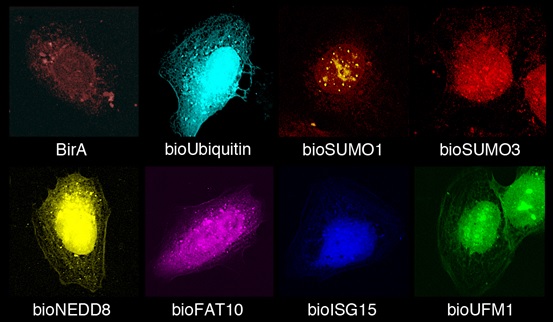
2017/01/20
A comprehensive biotin-based toolbox to study protein homeostasis: A community resource developed by CIC bioGUNE researchers
Protein homeostasis is at the heart of human wellbeing. Numerous diseases such as cancer and neurodegeneration are caused by imbalances in protein synthesis, degradation, and recycling. The family of ubiquitin-like proteins (UbLs) is responsible for the modification of multiple cellular proteins, which influences their functions and fates. Studying these modifications will be crucial to understand multiple diseases in which modification by Ubls is defective. The group of Dr Rosa Barrio at CIC bioGUNE (Derio), in collaboration with groups from the University of the Basque Country, CNRS (France) and Novo Nordisk Foundation (Denmark), has developed a comprehensive toolbox for studying UbL modifications. Consisting of a collection of DNA vectors that enable in vivo biotinylation and purification of target proteins, the platform allows UbL modifications to be examined in different cellular settings. This flexible and easy-to-use toolbox can be used in cell lines, in patient-derived cells, and in transgenic animals. The resource will provide a way to test UbL modifications in many laboratories, helping the community to understand better the role and regulation of protein homeostasis.
The project was made possible by generous funding from various local, national and international sources, including the Marie Curie ITN program “Upstream: European Research Training in the Ubiquitin Proteasome System” (http://www.upstreamproject.eu). The project benefited from networking under the frame of the COST action “PROTEOSTASIS” (http://cost-proteostasis.eu/), coordinated by Dr. Rosa Barrio, which brings together 250 research groups in 27 countries for networking and training opportunities in the field of protein homeostasis. The bioUbL resource and results were published in the prestigious journal Scientific Reports (http://rdcu.be/oCs2).
Figure caption
Cellular distribution of different bioUbLs. U2OS cells were transfected with plasmids expressing the indicated bioUbLs (bioUbiquitin, bioSUMO1, bioSUMO3, bioNEDD8, bioFAT10, bioISG15, bioUFM1) or BirA alone as a control. BioUbL conjugates were visualized using fluorescently-labeled streptavidin. Colors have been added to grayscale images.
See a large version of the first picture


